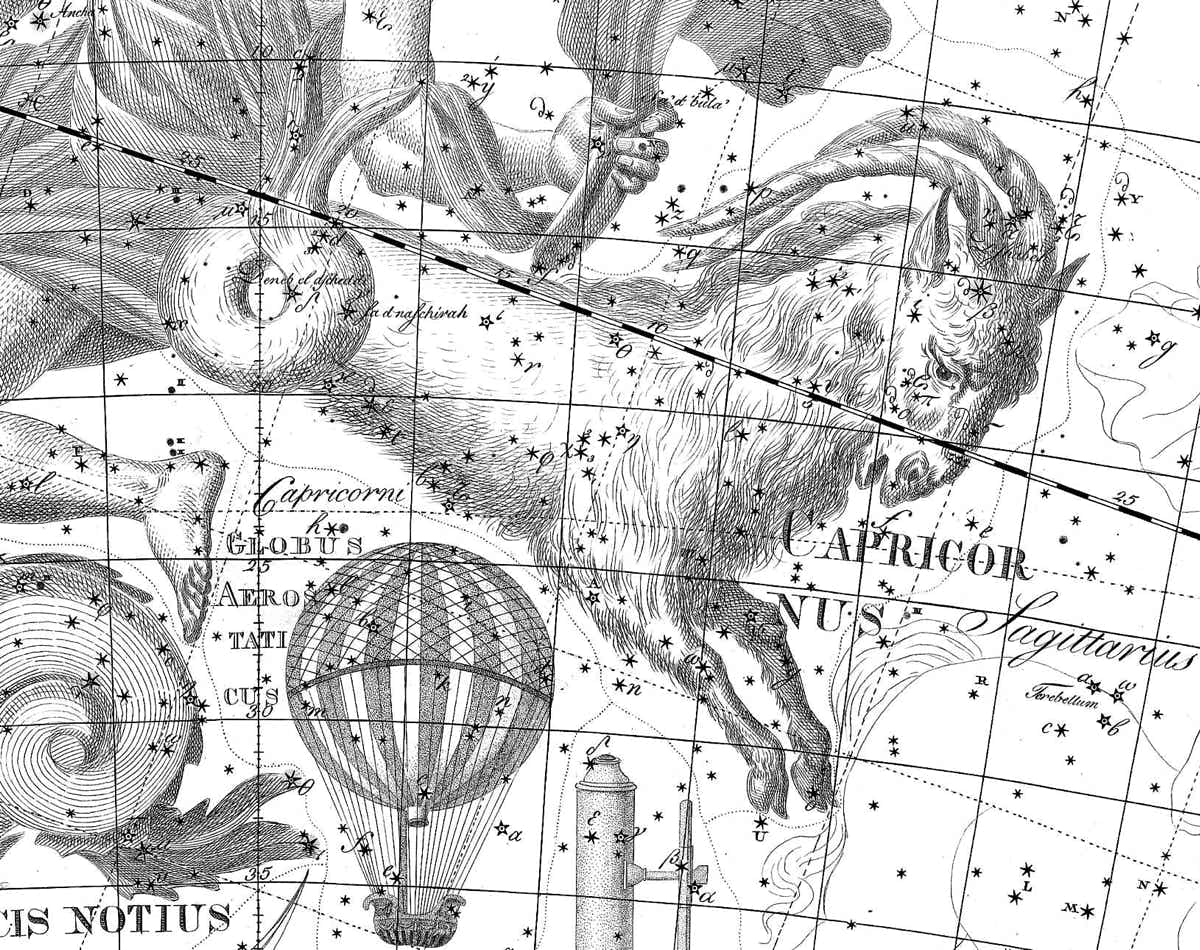
Genitive: Capricorni
Abbreviation: Cap
Size ranking: 40th
Origin: One of the 48 Greek constellations listed by Ptolemy in the Almagest
Greek name: Αἰγόκερως (Aigokeros)
Capricornus is an unlikely looking creature, with the head and forelegs of a goat and the tail of a fish. The constellation evidently originated with the Sumerians and Babylonians, who had a fondness for amphibious creatures; the ancient Sumerians called it SUHUR-MASH-HA, the goat-fish. But to the Greeks, who named it Αἰγόκερως (Aigokeros, or Aegoceros in Latin transliteration), meaning goat-horned, the constellation was identified with Pan, god of the countryside, who had the horns and legs of a goat.
Pan, a playful creature of uncertain parentage, spent much of his time chasing females or sleeping it off with a siesta. He could frighten people with his loud shout, which is the origin of the word ‘panic’. One of his offspring was Crotus, identified with the constellation Sagittarius. Pan’s attempted seduction of the nymph Syrinx failed when she turned herself into a handful of reeds. This transformation led to a happy discovery: as he clutched the reeds the wind blew through them, creating an enchanting sound. Pan selected reeds of different lengths and stuck them together with wax to form the famous pipes of Pan, also called the syrinx.
Capricornus as shown on Chart XVI of the Uranographia of Johann Bode (1801) with long horns curving backwards behind its head and a looping tail. South of it lies the abandoned constellation of Globus Aerostaticus, the hot-air balloon.
Pan came to the rescue of the gods on two separate occasions. During the battle of the gods and the Titans, Pan blew a conch shell to help put the enemy to flight. According to Eratosthenes his connection with the conch shell accounts for his fishy nature in the sky, although Hyginus says somewhat absurdly that it is because he hurled shellfish at the enemy. On a later occasion, Pan shouted a warning to the gods that the monster Typhon was approaching, sent by Mother Earth (Gaia) against the gods. At Pan’s suggestion the gods disguised themselves as animals to elude the monster. Pan himself took refuge in a river, turning the lower part of his body into a fish. It was on this same occasion that Aphrodite and her son Eros jumped into the same river, said by Hyginus to have been the Euphrates, and were turned into two fish, represented by the constellation Pisces.
Zeus grappled with Typhon, but the monster pulled out the sinews from Zeus’s hands and feet, leaving the god crippled. Hermes and Pan replaced the sinews, allowing Zeus to resume his pursuit of Typhon. Zeus cut down the monster with thunderbolts and finally buried him under Mount Etna in Sicily, which still belches fire from the monster’s breath. In gratitude for these services, Zeus placed the image of Pan in the sky as the constellation Capricornus.
Two horns and a looping tail
Ptolemy in the Almagest imagined the goat’s horns as short and straight, with Beta and Alpha Capricorni marking the right horn and Xi at the tip of the left horn. But Bayer showed them as much longer, with Alpha and Xi Capricorni at the base of the horns and Beta in the head, while Bode drew the horns as sweeping back over the goat’s neck (see illustration above). Flamsteed, with his concern for classical correctness, followed Ptolemy’s description more closely.
Alpha Capricorni is called Algedi, from the Arabic al-jady meaning ‘the kid’, the Arabic name for the constellation. Bode on his Uranographia (see chart above) called the star Dshabeh, evidently from the Arabic jabhah meaning forehead, but that name with slightly different spelling (Dschubba) is now given to Delta Scorpii. Beta Capricorni is named Dabih from the Arabic al-dhābiḥ meaning the slaughterer, a name that was originally applied to both Alpha and Beta Capricorni in reference to the ritual slaughter of a sheep; the sheep itself was represented by a fainter star nearby, Nu Capricorni.
Delta Capricorni is called Deneb Algedi, from the Arabic dhanab al-jady, ‘the kid’s tail’. Ptolemy described this as being the rearmost of the stars in the body of the goat, lying at the base of the tail. He listed four stars in the tail itself: we now know them as 42, Mu, Lambda, and 46 (c) Capricorni, the latter marking the tip of the tail, which iconographers traditionally drew as a loop, as in Bode’s representation above.
As defined by the modern IAU boundaries, Capricornus is the smallest of the 12 constellations of the zodiac, occupying less than a third the area of the largest zodiacal constellation, Virgo.
Tropic of Capricorn
The tropic of Capricorn is the latitude on Earth at which the Sun appears overhead at noon on the winter solstice, around December 22. In Greek times the Sun was in Capricornus on this date, but as a result of precession the Sun is now in Sagittarius at the winter solstice.
Chinese associations
Chinese astronomers linked Alpha, Beta, Pi, Omicron, Rho, and Nu or Xi Capricorni to form a noose-shaped constellation called Niu, ‘ox’, thought to represent an animal for the midwinter sacrifice. Niu was also the name given to the ninth lunar mansion. Next to the constellation Niu, three faint stars including Tau and Upsilon Capricorni formed Luoyan, a network of embankments or dikes to pen up water for irrigation. The water was presumably intended for the Emperor’s fields or farmland, Tiantian, in southern Capricornus; these fields were formed by nine stars (some say only four) including Psi, Omega, and 24 Capricorni. More water came from Jiukan, which lay farther south in present-day Microscopium.
Chinese astronomers gave names to a dozen individual stars and pairs of stars in Capricornus, known collectively as Shierguo, referring to 12 provinces of China. Their names and probable identifications were: Yue (19 Cap), Zhao (two faint stars, unidentified), Zhou (Eta and one other), Qi (Chi Cap), Zheng (20 Cap), Chu (Phi Cap), Qin (Theta and 30 Cap), Wei (33 Cap), Yan (Zeta Cap), Dai (Iota and 37 Cap), Han (35 Cap), and Jin (36 Cap).
To the east (left) of Qin and Dai, three stars oriented north–south formed Liyu, representing jade jewellery such as a brooch for a woman’s dress. Some sources place this in Microscopium or even Piscis Austrinus, but the close trio of 42, 44, and 45 Capricorni looks the best fit to the description.
Capricornus also contained parts of two Chinese constellations that spilled over from neighbouring Aquarius. The diamond shape formed by Gamma, Delta, Epsilon, and Kappa Capricorni was one end of Leibizhen, a long line of fortifications, while some faint stars in northern Capricornus were members of Tianleicheng, a castle with earthwork ramparts.
© Ian Ridpath. All rights reserved



